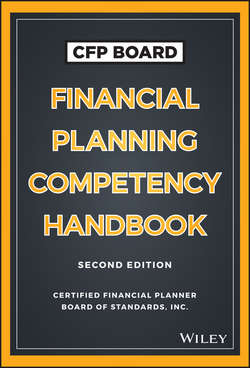Читать книгу CFP Board Financial Planning Competency Handbook - Board CFP - Страница 26
На сайте Литреса книга снята с продажи.
PART One
Introduction
CHAPTER 2
Function, Purpose, and Regulation of Financial Institutions
IN PRACTICE
ОглавлениеRebecca
Rebecca has been working in the financial services marketplace for 10 years. She began her career as a stockbroker at a regional firm. She easily passed the Series 7 licensing requirements necessary to sell securities to the general public. About three years ago, she started the process of converting her practice away from compensation strictly by commission to one primarily based on assets under management fees. She recently resigned her position as a broker and opened her own firm. She has $73 million in assets under management. Given her new business model and compensation approach, she must register as an investment advisor. Because her asset base is less than $100 million, she will register at the state level, unless her state does not require investment advisors to register. Rebecca must also hold either a nationally recognized certification, such as the CFP® mark, or a Series 7 and 65 license, in order to start her new practice.27 When the total value of assets managed by Rebecca exceeds $100 million, she will fall under the jurisdiction of the SEC; in the meantime, she must complete and file Form ADV as outlined in the Investment Advisers Act of 1940.
Janie
Is Janie a fiduciary? This is a question that has marked the twenty-first century as being unique in the history of financial planning as a profession. For many years, financial planners considered themselves primarily to be engaged to transact business for clients. Many planners still consider themselves in this role. Janie, however, views her position as a financial planner differently. She advertises her services to be fair and balanced. She believes in disclosing all real and perceived conflicts of interest. Rather than acting as an intermediary in the purchase and/or sale of a product or service, Janie considers herself to be a fiduciary – someone “who acts in utmost good faith, in a manner he or she reasonably believes to be in the best interest of the client.”28 Although national and international guidelines regarding fiduciary standards for financial planners are not uniform or necessarily similar, the Uniform Prudent Investor Act of 1994 helped promote discussion within the profession about the functioning of planner-client relationships. Some, such as Janie, would argue that all financial planners are, in fact, acting as fiduciaries. The debate regarding who is and who is not a fiduciary within the profession is certain to continue.
27
K. C. Garrett and J. E. Grable, “State Investment Adviser Representative Examination and Waiver Requirements,” Journal of Personal Finance 6, no. 1 (2007): 38–43.
28
CFP Board, Rules of Conduct, 2015. Retrieved from Certified Financial Planner Board of Standards, Inc.: http://www.cfp.net/for-cfp-professionals/professional-standards-enforcement/standards-of-professional-conduct/rules-of-conduct.
